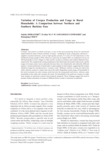Variation of Cowpea Production and Usage in Rural Households: A Comparison between Northern and Southern Burkina Faso
| ISSN | 00213551 |
|---|---|
| NII recode ID (NCID) | AA0068709X |

Cowpea, also known as black-eyed pea, is one of the most promising foods for nutritional improvement for many African countries. Cowpea—including its seeds, young pods, and leaves—supplies essential nutrients, such as high-quality protein. It is also of vital importance to the livelihood of many people in West Africa as a cash crop. In August 2018, we conducted a survey on 206 households in rural villages in Yako and Po, located in northern and southern Burkina Faso, respectively. We compared the cowpea production at the family plot and women’s plot levels, and the usages of cowpea seeds, leaves and pods between these two climatically and culturally different regions. Cowpea production in family plots is quite popular in both regions, suggesting that cowpea should no longer be considered just a “women’s crop.” Different varieties of crops are sold in the south, whereas cowpea is a major cash crop in the north. Regarding cowpea usage, all households in the north consume not only cowpea seeds but also the young pods and leaves, whereas some households in the south only consume the seeds. No households in the north use cowpea as a baby food, despite its nutritious content when properly prepared. These findings suggest the need to promote further utilization of cowpea in different forms in order to maximize its potential.
| Date of issued | |
|---|---|
| Creator | Sakiko SHIRATORI Eveline M. F. W. SAWADOGO-COMPAORE Hsiaoping CHIEN |
| Subject |
regional difference women’s role |
| Publisher | Japan International Research Center for Agricultural Sciences |
| Received Date | 2019-03-01 |
| Accepted Date | 2019-10-01 |
| Available Online | |
| Volume | 54 |
| Issue | 3 |
| spage | 263 |
| epage | 270 |
| DOI | 10.6090/jarq.54.263 |
| Language | eng |
